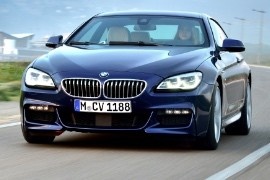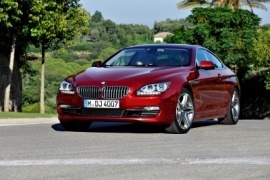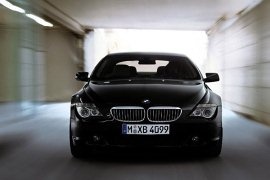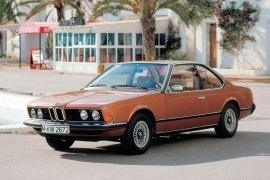
BMW 6 Series Coupe
Generations Timeline, Specs and Pictures

BMW had to comply with new Euro 6c emission regulations, and since it made some changes to the engines, it improved the rest of the 6-Series through a life-cycle-impulse in 2015.
After it reintroduced the 6-Series in 2003, BMW became a key player in the GT segment. But to keep the momentum, it changed it again with the third generation in 2011 and added a mid-life cycle refresh in 2015. While some modifications were barely visible, a trained eye would spot some differences.
At the front, the 2015 6-Series featured new LED fog lamps under the full LED headlights. BMW also replaced the front bumper with a new one that sported a wide center grille in the apron flanked by two side-scoops for additional cooling needs. In the middle, on the lower part of the bumper, the carmaker installed the radar system for the automatic cruise control. On its sides, the 2011 model featured a chromed trim around the window line, while the 2015 model didn’t. The facelifted version featured a new bumper design at the back, with reflecting red stripes above the middle section.
Inside, the 2015 model featured new piano-black trims on the center console, surrounding the climate control buttons. Its high-bolstered front bucket seats were covered in Dakota leather with an option for Nappa. But there was still not enough room for three passengers in the back or two tall adults for longer distances.
Under the hood, BMW installed Euro 6-compliant engines with either six or eight cylinders. A 313 hp turbo-diesel was specially built for European customers, while the U.S. buyers got only the twin-turbocharged 3.0-liter or the twin-turbocharged V-8. All versions were available with rear or all-wheel-drive and featured a standard eight-speed automatic gearbox.

BMW introduced the third generation of the 6 Series in 2011 as a coupe and, in the following year, as a four-door coupe named Gran Coupe.
The German carmaker made the 6 Series as a Grand Touring vehicle that could provide both the look and the performances of a personal luxury coupe.
It was clear that, apart from the ferocious M6, all the other versions were personal luxury coupes. They were designed with elegant-looking lines but still a bit aggressive, like a kickbox fighter dressed in a suit. The 2011 model, or the F12, featured elliptic headlights swept up and back onto the front fenders. With a profile that showed a raked windshield, a short roof, and a sloped-down rear windscreen, the 6 Series confirmed its status as a grand touring car.
Inside, the carmaker made the front seats as comfortable for long journeys as they could. The high-bolstered bucket seats with multiple adjustments helped anyone finding the proper driving position. On top of that, the two-way adjustable steering column eased the way. The dashboard featured a floating-design 7” infotainment screen on top of the center stack, with an option for a 10.2” display and a rounded instrument cluster. A tall center console separated the front seats into two separate areas and sporting the gear-lever and iDrive controller. The carmaker installed a bench for two occupants in the back, but it was difficult to host someone there for long journeys due to the limited legroom and headroom. It was ideal for long trips with a trunk that could get up to 460 liters (16.2 cu-ft).
Under the hood, BMW installed a wide engine range, both gasoline and turbo-diesel, ranged between 313 hp and 450 hp with rear or all-wheel-drive.

In 2003, after a 14 years gap, the 6 Series from BMW returned to grab the attention for the long-awaited GT offer from the Munich based car manufacturer.
But that wasn’t all.
In 2007, the BMW introduced a mid-life cycle improvement model for the 6-Series. There were some modifications both on the inside and the outside of the vehicle and, most important under the hood.
It needs a specialist designer to notice the differences between the 2003 and the 2008 model of the BMW 6-Series from the outside. The bumpers were different, with a deeper air-dam in the front and redesigned rear fog-lights. The headlights were changed but in such a way that it was very hard to tell. The rear lights though were switched to LED-type and the third stop-light was relocated from the rear window to the trunk-lid.
Inside, there were few minor changes for the climate control unit and an updated iDrive unit. On top of that, there were some buttons to change the gears but, somehow, the BMW engineers considered that it was OK to install both +/- buttons on each side of the steering wheel.
There were two completely new engines: a 3.0 liters turbodiesel unit for the European market which was badged as a 635d and another 3.0-liter gasoline engine for the 630i. The V8 was already replaced in 2006 and improved from a 4.4-liter to a 4.8-liter. The top-of-the-range was the mighty M6 with the biggest engine ever installed on the 6-Series: a 5.0-liter V10 naturally aspirated masterpiece.

The first generation of the 6-Series was built between 1976 to 1989 and its lines were highly appreciated by the customers.
It took another 14 years until the second generation of the 6-Series to be unveiled.
Designed under the Chris Bangle era, the second generation of the 6-Series was unveiled at the 2003 Frankfurt Auto Show. The design was controversial due to the rear end, nicknamed by the fans as “Bangle But” where the fender lines were not matching the trunk-lid. But the most important step was done: the 6-Series was back.
The front fascia featured unusual small headlights for the size of the car. The big, wide, grille was one of the vehicle’s signatures. An aerodynamically profiled bumper featured three air-intakes to help to cool the engine and the front brakes. The side sculptured doors and fenders increased the dynamic look of the car.
Inside, there was a luxurious GT-style vehicle, with two front bucket seats. In the rear, there was limited room for up to three passengers. The infotainment system was controllable via the rotary knob installed on the center console.
Under the hood, there were few engine options from 3.0-liter up to the mighty 5.0-liter V10 installed on the M6. The standard transmission for the base model was a 6-speed gearbox, while the 4.4-liter and the M6 were equipped with a 6-speed automatic and a 7-speed single-clutch, respectively.

The BMW 635 CSI was the most powerful version of the first generation of the 6 series coupe at the time of its launch on the market in 1979.
It was a coupe faster and more comfortable than other GT vehicles on the market.
After the successful BMW 3.0 CS at the beginning of the ’70s, the German company needed a replacement. Paul Braq designed a new vehicle based on the already existing platform of the BMW 5-Series, which allowed the use of 4 and 6 cylinder engines. But for a performance coupe, BMW didn’t want to use an inline-four and chose only the inline-six units. Even though it was considered the two-door version of the 7-Series, it was a mix between the 5-Series platform and 7-Series design cues.
The first generation of the 7-Series and the 6-Series were designed by the same team and that is why they are similar in shapes. The shark-nose design and the descending trunk line were similar. But unlike the executive sedan, the 6 Series featured frameless windows for the doors and only two seats in the back. The dashboard featured a centers stack tilted toward the driver and the instrument cluster featured four dials. It was the same layout kept by the German car-maker for over two decades: coolant temperature, tachometer, speedometer, and fuel level.
The engine was a 3.5-liter inline-six with a broad torque range that helped the car pull in every of its standard 5-speed gearbox. The up-mounted gear-stick was one of its main advantages over other luxury coupes on the market. It was available with an automatic transmission as well, named 635 CSI A.

BMW took a gamble when it introduced the first generation of the 6-series, but the sales of that magnificent coupe rewarded its hopes.
The German carmaker had to retire the already old E9 series, and it didn’t have a proper replacement for it. It had an excellent new platform from the first generation of the 5-series (the 1972 E12) and a new design language introduced by the 3-Series in 1971. Unlike the smaller sibling, the 6-Series was made as a large coupe with a grand-tourer inspiration.
With a design signed by Paul Braq and its fake-cabriolet bodywork, the 6-Series quickly became a very thought-after car. Mercedes-Benz didn’t have anything to offer on the same segment, and its closest rival on the European market was the Jaguar XJS, which was pricier than the German coupe. Its rear-raked front fascia resembled a shark-nose, and the chromed, wrapped-around bumper made the car looks sporty.
The same team designed the first generation of the 7-Series and the 6-Series, and that is why they are similar in shapes. The shark-nose design and the descending trunk line were similar. But unlike the executive sedan, the 6 Series featured frameless windows for the doors and only two seats in the back. The dashboard featured a centers stack tilted toward the driver, and the instrument cluster featured four dials. The German carmaker kept the same layout for over two decades: coolant temperature, tachometer, speedometer, and fuel level.
When BMW introduced the 6-Series on the market, it relied on a 3.0-liter inline-six engine fed by a carburetor and paired to a 4-speed manual. After the carmaker noticed the car’s success, it decided to give it more power and more features to make it more appealing for wealthier customers.























































